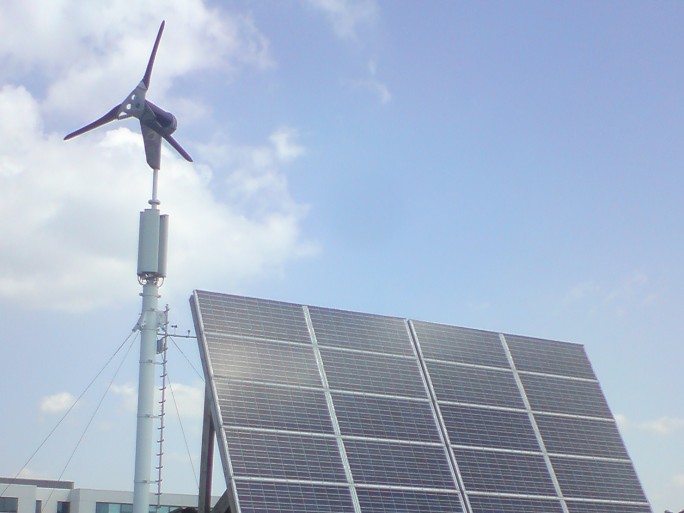Cell Tower Combines Solar And Wind Power

A mobile phone base station from Alcatel Lucent could reduce the carbon footprint of networks by combining renewable energy sources
Alcatel Lucent is offering developing countries a mobile phone base station that combines solar cells and a wind turbine to reduce its cost and environmental impact.
In some countries, the majority of cell towers have to be powered by continuously operating diesel generators or ”gensets” because the electric grid is too unreliable. Alcatel Lucent is already supplying the base stations to Vodafone in Qatar, reducing its energy need and contributing to Alcatel Lucent’s “Green Touch” initiative, which aims to reduce the emissions produced by networks a thousandfold.
Many mobile networks run on diesel
 “In most emerging markets the telecoms network runs on diesel fuel which has to be delivered to the base stations by truck,” said Laurent Wauquiez, strategic marketing manager for wireless at Alcatel-Lucent. demonstrating the system at an open day at Villarceaux, the French location for Alcatel Lucent’s Bell Labs research unit.
“In most emerging markets the telecoms network runs on diesel fuel which has to be delivered to the base stations by truck,” said Laurent Wauquiez, strategic marketing manager for wireless at Alcatel-Lucent. demonstrating the system at an open day at Villarceaux, the French location for Alcatel Lucent’s Bell Labs research unit.
Although many efforts to power cell stations have focused on solar power, it turns out that solar and wind combined make a more reliable pairing and, with suitable strengthening, cell towers can hold a wind turbine that provides more than half the power required by the cell network.
Our picture shows the demonstration set-up at Villarceaux using a conventional turbine tower which actually produces less wind power than can be gained from the top of a cell tower. “Most turbine providers offer a 15m high mast, but a cell tower is 50m high. The wind is better at that height – although we sometimes have to strengthen the tower,” said Wauquiez.
Alcatel Lucent provides technology to manage the use of both renewable sources and the back-up diesel generator, in such a way as to maximise the life of batteries and provide the necessary wireless coverage. The batteries are housed under a corrugated shed designed to provide as much free-air cooling as possible, reducing the energy demands of the network furhter.
Reducing fuel bills by 90 percent
As well as a demonstration set up in France, eWEEK saw live data apparently coming from a base station in Qatar which (at 11am local time) was using 1.1kW, while receiving 0.7kW from the sun and 1.2kW from the wind. Both renewables were providing a good stream of energy, and 0.9 kW were being fed into the batteries to keep the cell tower going at night.
The system has been used to reduce the fuel bills of some operators by 90 percent, in countries where diesel makes up 35 percent of the operator’s energy bill, eWEEK Europe was told. “In Kenya for instance, the leading mobile operator has to maintain a fleet of 100 fuel tankers.”
Alcatel launched its Green Touch initiative in January 2010, and hopes to reduce the energy requirements and CO2 emissions of the world’s networks by a factor of a thousand in the next ten years. It has published details of its solar/wind powered base station on its blog.
As well as cell-towers, phones themselves can also be powered by solar energy. This can either be done with separate solar power units, or increasingly in panels built into phones designed for third world use. One thousand of these phones were sent to Haiti after the earthquake in January, to help survivors and aid workers communicate.
Alcatel’s Green Touch is working to reduce the overall energy needs of networks. This includes providing energy in more sustainable ways, but has a long term goal of actually reducing the energy required by networks. One approach to this, shown at the Open Day, would be to use more efficient protocols: Bell Labs also discussed a possible successor to LTE which would use far less energy than today’s mobile networks.